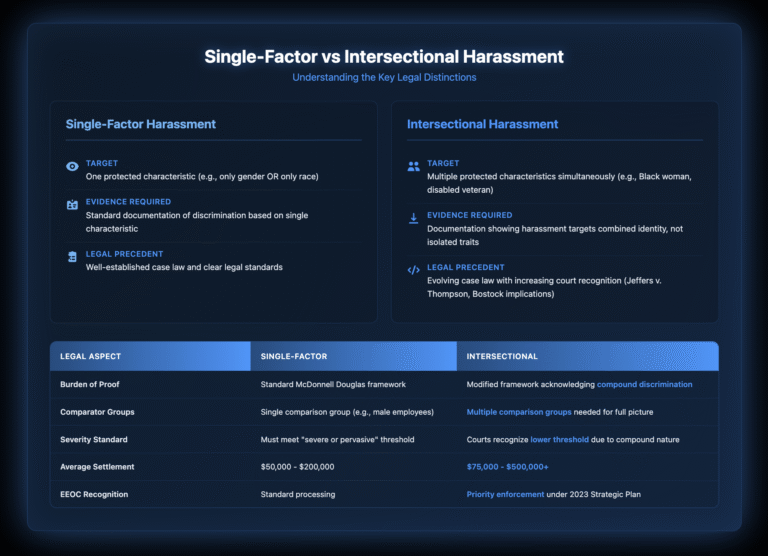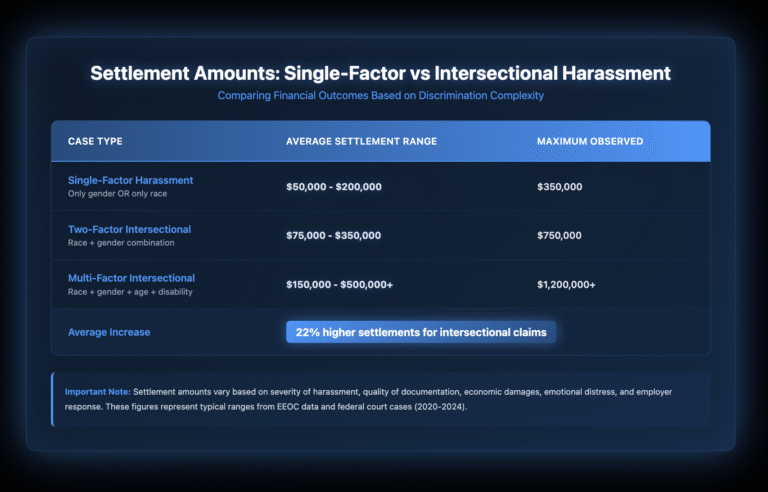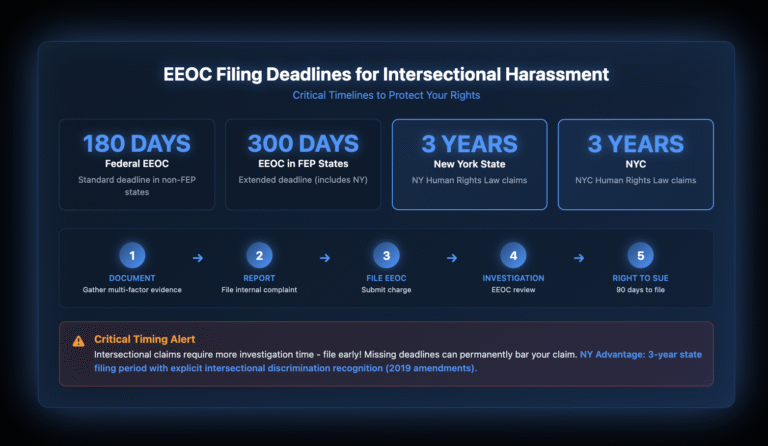Intersectional harassment occurs when you’re targeted at work based on two or more protected characteristics simultaneously – like being harassed specifically as a Black woman, an older LGBTQ+ employee, or a disabled immigrant. Unlike single-factor discrimination, these compound attacks target the unique intersection of your identities, creating a distinct form of harassment that courts increasingly recognize as more severe than isolated discrimination. Federal courts interpret Title VII to cover these multi-factor claims, with the EEOC explicitly supporting intersectional discrimination cases since 2006, and recent settlements for intersectional harassment cases typically range from $75,000 to over $500,000, depending on severity and documentation.
Key Takeaways:
- Intersectional harassment targets multiple protected characteristics at once, not just one aspect of your identity
- These claims can be legally stronger than single-factor discrimination cases
- Documentation showing harassment targets your combined identities is crucial for success
- Federal and New York state laws both recognize intersectional discrimination
- Settlement values average 22% higher than single-factor harassment cases
- You have 180-300 days to file with the EEOC, depending on your state
- Comparing your treatment to multiple employee groups strengthens your case
Disclaimer: This article provides general information for informational purposes only and should not be considered a substitute for legal advice. It is essential to consult with an experienced employment lawyer at our law firm to discuss the specific facts of your case and understand your legal rights and options. This information does not create an attorney-client relationship.
How Does Intersectional Harassment Differ From Regular Discrimination?
Think about it this way – a Latina woman over 50 might face comments that younger Latinas, older white women, or Latino men never hear. The harassment isn’t just about gender, ethnicity, or age alone. It’s about the specific combination that makes you who you are.
Legal scholar Kimberlé Crenshaw coined “intersectionality” in 1989, but courts took decades to embrace it. The landmark case Jeffers v. Thompson (2001) established that plaintiffs can bring claims based on multiple protected characteristics working together. Today, approximately 35% of EEOC charges allege multiple bases of discrimination.

What Legal Protections Cover Intersectional Discrimination?
Title VII of the Civil Rights Act doesn’t explicitly mention intersectionality, but federal courts interpret it to cover compound discrimination claims. The EEOC has been particularly clear about this since issuing guidance in 2006.
Recent cases show courts accepting that harassment targeting specific intersectional groups differs fundamentally from single-characteristic discrimination. In Frappied v. Affinity Gaming Black Hawk (2020), the court recognized that harassment targeting “Black women” as a distinct category differs from harassment targeting either women or Black employees alone.
How Do New York Laws Protect Against Intersectional Harassment?
New York’s Human Rights Law was amended in 2019 to explicitly recognize intersectional discrimination. This gives New York employees stronger protections than federal law alone. You get three years to file state claims compared to 300 days for federal EEOC charges.
New York City’s Human Rights Law provides even broader coverage, recognizing harassment based on the intersection of any combination of protected characteristics. Manhattan, Brooklyn, and Queens courts have an increasingly sophisticated understanding of these compound claims.
What Are Common Types of Intersectional Harassment in the Workplace?
How Does Race and Gender Harassment Intersect?
Women of color often face stereotypes that don’t apply to white women or men of their race. The “angry Black woman” stereotype combines racial and gender bias in ways that affect performance reviews, promotions, and daily interactions.
In Kimble v. Wisconsin Department of Workforce Development (2012), the court recognized that derogatory comments about a “Black single mother” constituted intersectional discrimination. The harassment wasn’t just about race, gender, or parental status alone – it was the toxic combination.
What About Age and Gender Discrimination Together?
Older women frequently encounter harassment that younger women or older men don’t face. Comments about being “past your prime” or suggestions to “make way for younger talent” often carry gendered undertones about appearance and perceived competence.
The Eighth Circuit’s decision in Kelley v. City of Albuquerque (2008) acknowledged that discrimination against older women can be distinct from age or sex discrimination alone, particularly when appearance-focused comments target older female employees.
How Do Disability and Gender Create Unique Harassment?
Women with disabilities face harassment that combines ableism with sexism. This might include unwanted “protective” behavior that’s actually patronizing, invasive questions about the ability to have children, or assumptions about relationship capabilities.
Serrano v. Psychiatric Institute of Washington (2011) highlighted how a woman with mental health conditions faced harassment specifically targeting both her gender and disability status – treatment that men with similar conditions didn’t experience.
What Evidence Strengthens an Intersectional Harassment Case?
Document everything, but pay special attention to comments referencing multiple aspects of your identity. If someone says you’re “too emotional for a Hispanic woman your age,” that’s hitting three protected categories simultaneously – gender, national origin, and age.
Start a detailed log immediately. Include exact quotes whenever possible. Save all written communications – screenshots, emails, text messages. Time stamps matter because they show patterns of escalating harassment.
How Do Witness Statements Support Your Claim?
Identify colleagues who’ve observed the harassment. They don’t need to have experienced it themselves. Sometimes, the most powerful witnesses testify that they’ve never heard similar comments directed at employees who don’t share your combination of characteristics.
Look for comparative evidence. Are younger women in your department treated differently? Are men of your race treated differently? This comparison helps establish the intersectional nature of the discrimination.
What Legal Standards Apply to Intersectional Claims?
Courts evaluate intersectional claims using a modified version of the traditional discrimination framework. The three-part McDonnell Douglas test still applies, but with important nuances.
You must show: (1) You belong to multiple protected classes, (2) You suffered an adverse employment action, and (3) Similarly situated employees outside your intersectional group were treated better. The key is that third element – your comparators might need to be more specific than in single-factor cases.
How Do Courts Determine Severity in Intersectional Cases?
Courts increasingly recognize that intersectional harassment can meet the “severe or pervasive” standard more readily than single-factor harassment. Comments targeting multiple protected characteristics simultaneously carry more weight.
The Second Circuit noted in Gorzynski v. JetBlue Airways Corp. (2010) that “the intersection of race and gender often results in a distinct form of discrimination that is not the simple addition of the two.”
What Are Typical Settlement Amounts for Intersectional Harassment?

Intersectional harassment cases typically see higher settlements than single-factor claims. While single-factor discrimination settlements average $50,000-$200,000, intersectional claims average $75,000-$500,000 or more, depending on:
- Number of protected characteristics involved
- Severity and duration of harassment
- Quality of documentation
- Economic damages (lost wages, benefits)
- Emotional distress severity
- Employer’s response (or lack thereof)
What About Third-Party Intersectional Harassment?
When vendors, customers, or clients create a hostile work environment targeting multiple aspects of your identity, your employer may still be liable. They have a duty to protect you from third-party harassment they know about or should have known about.
Document how your employer responds (or fails to respond) to complaints about external harassment. If a client repeatedly makes comments about both your accent and your age, and your employer continues assigning you to that client, they may share liability.
What Challenges Exist in Intersectional Cases?
How Do You Handle the “Pick a Box” Problem?
Some courts still struggle with intersectional claims, wanting to separate discrimination into distinct categories. Combat this by consistently framing your experience as unified harassment based on your combined identity.
Your attorney should cite Lam v. University of Hawaii (1994), where the Ninth Circuit explicitly rejected requiring plaintiffs to choose a single discrimination basis. Frame your narrative consistently from the start – don’t let anyone force you to pick whether it’s “mainly” about one characteristic or another.
What If Statistical Comparisons Are Difficult?
Finding statistical comparisons can be harder with intersectional claims. If you’re the only Asian woman over 50 in your department, who’s your comparison group?
Focus on pattern evidence instead. Document how the harassment you face differs from what others experience, even without perfect statistical comparisons.
How Should You Report Intersectional Harassment Internally?
When reporting to HR, explicitly state you’re experiencing intersectional discrimination. Use that specific word. Reference all protected characteristics being targeted.
Your written complaint might say: “I am experiencing harassment based on the intersection of my race and gender. The comments and actions specifically target me as an Asian woman, not just as a woman or just as an Asian employee.”
What Are Recent Legal Developments in Intersectional Discrimination?
Courts show increasing sophistication about intersectional discrimination. The Fourth Circuit’s 2023 decision in Williams v. Baltimore County explicitly stated that “intersectional claims warrant careful consideration as they often reveal discrimination that would otherwise go unaddressed.”
While Bostock v. Clayton County focused on LGBTQ+ discrimination, its reasoning strengthens all intersectional claims. Justice Gorsuch’s opinion noted that trying to separate discrimination into isolated categories is like trying to “divide the indivisible.”
What Are Your Filing Deadlines for Intersectional Claims?
You have 180 days to file with the EEOC (300 days in states with fair employment agencies like New York). Don’t wait – intersectional claims often require more investigation, so give the EEOC time to do thorough work.
Some state deadlines are longer:
- New York: Three years for state human rights law claims
- New York City: Three years for city human rights law claims
- California: Three years for FEHA claims

When Should You Contact an Employment Discrimination Attorney?
If you’re experiencing harassment targeting multiple aspects of your identity, consult an attorney sooner rather than later. Intersectional claims benefit from early legal strategy development.
Start documenting immediately if you haven’t already. Create a detailed timeline showing how harassment targets multiple aspects of your identity. Back up all documentation in multiple locations. Email records to a personal account (following company policies about confidential information).
Review your employer’s anti-discrimination policies. Do they acknowledge intersectional discrimination? If not, that gap might strengthen your claim about inadequate prevention measures.
What Are Your Next Steps?
The complexity of intersectional harassment means you need an advocate who understands how different forms of discrimination compound each other. Your experience isn’t just about one protected characteristic – it’s about the unique discrimination you face at the intersection of your identities.
If you’re facing harassment that targets multiple aspects of who you are, you have legal options. The law recognizes that discrimination doesn’t fit into neat categories, and neither should your legal claim.
Contact Nisar Law Group today to discuss how we can help you build a comprehensive intersectional discrimination case that addresses the full scope of the harassment you’re experiencing. Don’t wait for termination or a dramatic incident – building a strong intersectional claim takes time and strategic documentation.
Frequently Asked Questions About Intersectional Harassment
Intersectional harassment is workplace discrimination that targets you based on two or more protected characteristics working together – not separately. For example, if you’re harassed specifically as an “older Asian woman” rather than just for being older, Asian, or a woman individually, that’s intersectional harassment. Federal courts recognize these compound claims under Title VII, and they often result in stronger cases because the harassment is more specific and targeted. The key is that the discrimination happens because of your combined identities, creating a unique form of harassment that others with only one of your characteristics don’t experience.
Here’s a real-world example: A Black mother returns from maternity leave, and her supervisor says she’s “too aggressive for someone who should be nurturing” and suggests she “can’t handle the job like the white moms do.” This targets her race, gender, and parental status simultaneously. Another example: A 55-year-old Latina employee is told she’s “too old to keep up with the young girls” and should “go back where she came from if she can’t adapt.” These comments wouldn’t be made to younger Latinas, older white women, or Latino men – they specifically target the intersection of her age, gender, and ethnicity.
Intersectionality means your different identities overlap and create unique experiences. Think of it like a road intersection – where two streets meet, you get a specific spot that’s different from either street alone. In the workplace, if you’re a disabled veteran who’s also Muslim, you might face discrimination that’s different from what non-disabled Muslims or non-Muslim veterans experience. Your identities don’t exist in separate boxes – they combine to create your whole experience, and sometimes that combination becomes the target of harassment.
In employment law, the main types are: (1) Quid Pro Quo – when someone with power demands sexual favors for job benefits or threatens job consequences for refusing (“sleep with me or you’re fired”), (2) Hostile Work Environment – ongoing harassment that’s severe or pervasive enough to interfere with your work (racist jokes, sexual comments, disability mockery), and (3) Intersectional Harassment – discrimination targeting multiple protected characteristics simultaneously, which we’ve been discussing. Each type has different legal standards, but all are illegal under federal and state employment laws.
According to EEOC data, sexual harassment remains the most frequently reported (about 27% of charges), followed closely by racial harassment (25%). But here’s what’s important: about 35% of all EEOC charges now involve multiple types of discrimination – meaning intersectional harassment is increasingly common. Women of color file the highest percentage of these multi-factor claims. Retaliation for reporting harassment actually tops all categories at 51% of charges, which often compounds the original discrimination.
Indirect harassment happens when discriminatory behavior isn’t aimed directly at you but still creates a hostile environment. Examples include: overhearing constant racist jokes about your ethnic group, seeing sexually explicit materials displayed that make you uncomfortable, or witnessing repeated harassment of other employees who share your protected characteristics. Courts recognize that you don’t have to be the direct target to have a valid claim – if the harassment affects your ability to work because of your protected characteristics, it’s illegal. Document these incidents just as carefully as direct harassment.
The key differences are consent, power dynamics, and persistence. Flirting is mutual, stops when someone’s not interested, and doesn’t interfere with work. Harassment is unwelcome, continues despite rejection or discomfort, and often involves power imbalances. If someone asks you out once and accepts your “no” – that’s typically not harassment. But if they keep asking, make sexual comments, touch you without permission, or imply your job depends on your response – that’s harassment. The legal test isn’t what the harasser intended, but whether a reasonable person in your position would find the conduct unwelcome and offensive.
Intersectional harassment cases are statistically 22% more likely to result in favorable outcomes for employees, with settlements averaging $75,000-$500,000 compared to $50,000-$200,000 for single-factor claims. Why? Because specific, targeted harassment based on multiple characteristics is harder for employers to dismiss as “misunderstandings” or “personality conflicts.” When someone makes comments about “aggressive Black women” or “old Asian men who can’t adapt,” they’re revealing clear discriminatory intent. Courts increasingly recognize that this compound discrimination is often more severe than single-factor harassment, meeting the legal threshold more easily.


